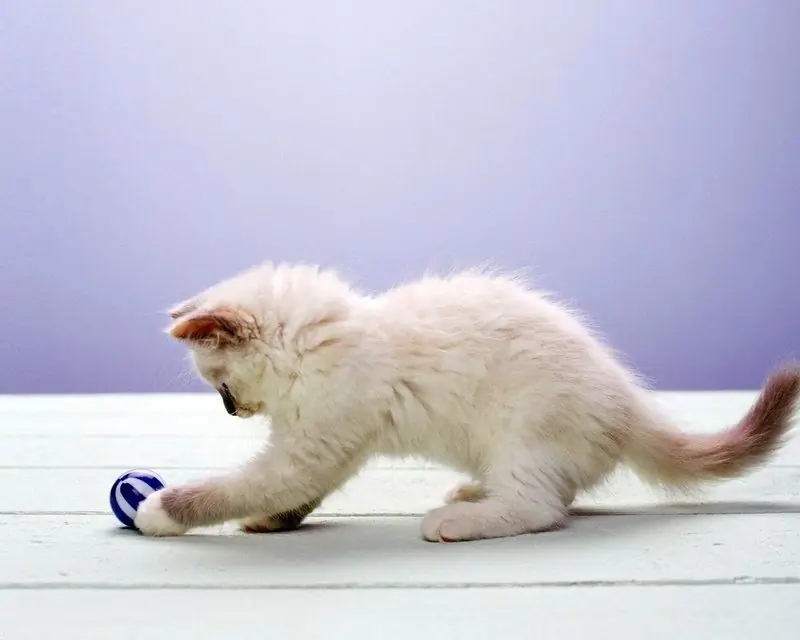
Table of contents:
- Author Bailey Albertson [email protected].
- Public 2024-01-17 22:26.
- Last modified 2025-01-23 12:41.
Why should a cat need a mustache

The cat is rightfully ranked first among the coziest pets. Her purr calms and relaxes, soft fur gives pleasant sensations, and unobtrusive nature makes communication comfortable. The structure of a cat sometimes raises many questions among lovers of this animal. In particular, whiskers: what are they for, what functions do they perform, how important is it for a cat to have them? It's time to look into this issue.
Content
- 1 What is the correct name for a mustache and why
-
2 Features of the structure of the whiskers in cats and cats
- 2.1 Locations
- 2.2 Length
- 2.3 Thickness
- 2.4 Other structural features
- 2.5 Photo gallery: baleen cats
-
3 What are the functions of whiskers in cats and cats
- 3.1 Touch
- 3.2 Navigation
- 3.3 Hunting
- 3.4 Communication
- 3.5 Can you trim a cat's whiskers
- 3.6 Video: why cats need whiskers
-
4 Mustache problems in cats and cats
- 4.1 Brittle
- 4.2 Loss
- 4.3 Poor growth
- 5 Reviews of mustache problems in cats
What is the correct name for the mustache and why
In fact, the mustache is the common name for a very important organ. Vibrissae - this is their scientific name (from the word "to vibrate", translated from the Latin vibro - to vibrate, wriggle), which they received due to the constant small tremor, vibration. If you look closely at the cat's face, you can see that the whiskers are constantly quivering.
Features of the structure of the whiskers in cats and cats
There is no difference in the structure of vibrissae in cats and cats. This body is not related to the gender of the animal, it performs the same functions. The difference may be slight in length and thickness. But this is solely due to genetics.
Locations
There is a widespread belief that vibrissae in cats are only on the muzzle. Long, thick hairs have been seen here and everyone knows. They are located:
- around the nose;
- on the circumlabial pads;
- above the eyes;
- on the lower jaw, more precisely, on the chin.
But the same is on the front legs. True, they are not so noticeable. But it is enough to look closely at the paw just above the place where the dewclaw is located, and you will easily find them.

Vibrissae are located not only on the face, but also on the paws of the cat
Length
The length of the whiskers on the cat's muzzle is on average 5-7 cm. But in this matter, much depends on the breed. So, the owners of the longest mustache are Maine Coons. Their vibrissae give incredible charm to an already charismatic appearance. In sphinxes, on the contrary, vibrissae are very short, moreover, they are often also twisted. The owners of curly whiskers are cats that carry the Rex gene. The name of these breeds contains the prefix "Rex". For example: Cornish Rex, Devon Rex and others.
The length of the vibrissae is also determined by the cat's nutrition. If balanced, the mustache will be truly luxurious.
Thickness
The thickness of the whiskers varies only by gender: cats have thicker mustaches than cats. By location, you can also identify differences:
- the whiskers on the cheeks are much thicker than above the eyes;
- on the forepaws vibrissae are only slightly ahead of the animal's guard hairs in thickness.
In general, the thickness of vibrissae is explained by the fact that the place where each hair grows is rich in nerve endings. And if we take into account that their number is quite large, it becomes clear why it has a tubercle at the base of vibrissae.
Other structural features
By themselves, vibrissae are already a very mysterious organ. Each hair has a connection with its own part of the brain and is responsible only for a certain function. Therefore, if the cat loses any of the antennae, then temporarily it experiences problems in hunting, coordination, touch, etc.

Each antennae is supplied with nerve endings and has its own "representativeness" in the brain
Photo gallery: baleen cats
-

Maine Coon with a long mustache - Maine Coon is a breed characterized by the length of the mustache
-

Don Sphynx with a curled mustache -
Small curled antennae are allowed in the Don Sphynxes
-

Black cat with white mustache - For some cats, a mustache is not only a necessity, but also a decoration.
-

Fluffy kitten - Fluffy cats and mustaches match them
What are the functions of whiskers in cats and cats?
From all of the above, it becomes clear that a mustache is not just ordinary wool. This is a whole animal's sense organ, the so-called mechanosensitive, which regulates the entire cat's life: from safety to communication with their own kind.
Touch
Vibrissae are primarily responsible for touch. With the help of the whiskers, the cat will accurately determine the degree of freshness of food and its safety.

Mustaches determine the quality of food and water before the tongue.
Navigation
Any owner of his cat knows about her ability to move in absolute silence and darkness, when her eyes and ears can do absolutely nothing to help the animal. This "trick" turns out only thanks to vibrissae. Being in absolute darkness, the cat, touching the objects with its whiskers, will calmly go around them. She does not even need to touch them: the mobile hairs, vibrating, create air vibrations, which in turn, reflecting from objects, return back and are captured by vibrissae. The received signals are transmitted to the brain, and the animal receives a three-dimensional picture of the surrounding space.

Whiskers help the cat to navigate even in pitch darkness
Another pleasant moment for the animal is the ability to determine the diameter of the hole into which the cat is going to crawl. Since the length of the whiskers is greater than the width of the head and is equal to half the circumference of the cat's body, the animal easily understands whether it will crawl into this gap or not (even rushing headlong from danger).
Hunting
Whiskers are also indispensable helpers for a cat when hunting. The slightest vibrations in the air created by a running mouse are instantly captured by the cat. The huntress can easily determine the location of her prey, its position, condition, direction of movement. Once the victim is caught, it disappears from the cat's field of vision. The vibrissae on the front legs come to the rescue. With their help, the cat will determine the position of the prey, assess the situation and be able to control the behavior of the victim.

Whiskers help the cat to hunt by communicating the slightest changes in the position of the victim's body
Communication
For its fellows, during communication, a cat uses not only a mustache. Everything is clear there. What about a person? An attentive owner understands what the position of the whiskers on the animal's face means, but it would be useful for guests to find out the cat's reaction to the appearance of a stranger next to her:
-
If the animal is in a friendly mood and the presence of a stranger is of interest, then the cat's whiskers are directed forward to the subject of study. They look like a beam locator.

The cat's whiskers are directed forward Whiskers pointing forward give out the cat's interest in what is happening.
- If the animal has pressed its whiskers, and along with them the ears, then it is worthwhile to postpone stroking. The cat is clearly either scared or aggressive. And it's good if she just runs away, otherwise some good scratches and bites are guaranteed.
Can you trim a cat's whiskers?
Since whiskers are vital for a cat, losing them will make life difficult. Of course, over time, compensatory mechanisms will come into force, and the animal will adapt to do without additional information about the world around it, but it will still not be such a full life that an animal could have. Therefore, you cannot trim the mustache of a cat.
Video: why cats need whiskers
Mustache problems in cats and cats
Whiskers are not only an organ that helps a cat in its difficult life as a predator, it is also a good signaling of health problems. Whisker problems can affect your cat's quality of life. Therefore, it is necessary to monitor the condition of vibrissae and take timely measures to eliminate all kinds of troubles that may affect them.
Fragility
Mustache brittleness appears due to some deviations in the environment. So, for example, dry air in a room leads to dryness of a hair and its breakage. Lack of fresh water in a cat and, as a result, insufficient fluid intake affects the mustache in the same way. Frequent bathing also has a negative effect on the elasticity of the antennae. If you still use a low-quality tool, then the result will not be long in coming.

Broken whiskers can be a sign of insufficient fluid intake.
The solution to these problems is obvious:
- normalization of humidity (if the pet lives in an apartment);
- availability of fresh water;
- the use of quality hair care products.
Dropping out
The falling off of the mustache is a more serious signal than breaking it off. If fragility is mainly influenced by the environment, then the loss is due to health problems.
Loss of vibrissae often accompanies cat allergic reactions. As a rule, pet allergies occur to food, most often to milk and fish. Associated symptoms are clearly visible:
- hair loss;
- lacrimation;
- stool disorders.
When faced with the loss of whiskers, you should pay attention to the cat's diet.
Avitaminosis also causes massive mustache loss. It occurs against the background of a monotonous diet, which causes a deficiency of important trace elements and vitamins.
Infection with parasites is another important factor. The fact is that the waste products of helminths are very toxic. They are capable of causing allergies even in humans, up to Quincke's edema, to say nothing of cats. Intoxication of the body leads to a poor supply of nutrients to the hair follicle in which the vibrissa is located, which leads to its death and loss. Some cats are allergic to flea saliva, which can also cause whiskers to fall out.
A fungal infection of the skin, causing flaking and itching, also signals its appearance by the loss of vibrissae.
To solve these problems, it is necessary to contact the veterinarian as soon as possible, who will prescribe treatment.
Poor growth
Poor whisker growth depends primarily on the general condition of the cat. The quality of food, the presence of vitamins and minerals, good care of the coat - all this is directly related to the growth of not only the whiskers, but also the animal itself. Poor mustache growth can also be caused by endocrine problems, metabolic disorders.
If the improvement in the quality of keeping the cat does not lead to a positive result, consultation with a specialist is necessary.
Reviews about mustache problems in cats
Once I picked up a kitten on the street. I examined his mustache later. I considered my first duty to treat him from fleas and worms. But when the baby had already eaten a lot, I noticed that some of his antennae were broken. There was no Internet in those years, and I did not even think to go to the doctor with such a problem, I blamed everything on the difficulties of a wandering life. Over time, the antennae recovered (apparently, the broken ones fell out, and the new ones grew already good).
A mustache is an amazing tool that a cat is fluent in. Hunting, orientation, communication - all this is completely impossible in the absence of them. People can only envy the perfection and foresight of nature.
Recommended:
Interesting Facts About Cats And Cats: What Taste They Don't Feel, Do They Sweat, Do They Understand Human Speech And Answers To Other Questions

How cats differ from humans. How cats feel, hear, see, remember. Their relationship to the game. What does purr and tail wagging mean. Reviews
Why Do Cats Bite When You Stroke Them, And Just Like That?

Why do cats bite when you stroke them. Why do cats just bite?
Why Cucumbers Have Pimples And Why Are They Needed

Why. Cucumbers are smooth and pimpled. Why does a cucumber need pimples. Which cucumbers are best for pickling, and which ones for salad
Why You Can't Step On Graves In A Cemetery And What Will Happen If You Break The Ban

Why you can't step on graves in a cemetery: superstition, church opinion, and rational reasons
Abandoned Cities Of Russia, Why Did They Become Like This

The history of several abandoned cities in Russia: the reasons why they ceased to exist
